VANCOUVER’S
PRE
WW1 ROLLS-ROYCE CARS AND THEIR OWNERS
by John Peirson (an
obsessed Rolls-Royce owner since 1962).
Note: this article was originally presented at the
November 2005 meeting of the VCCC Antique Chapter.
Thank you to John Peirson for giving permission to reproduce it here.
This is a story of the
four Rolls-Royce cars that came to Vancouver before World War I, and
of the people in Vancouver that chose to buy such expensive cars. I
hope that some of the names will be familiar to some of you.
Picture No. 1 shows Mr
Rolls and Mr Royce. Rolls was the Honourable Charles Rolls, second
son of Lord Llangattock, born in 1877, a graduate of Eton School and
Cambridge University, a very wealthy upper-crust aristocrat. At
university he was a prominent bicycle racer, then he took up car
racing and by 1900 was England’s most prominent motorist. He won
the gold medal in the 1000 miles trial of 1900. He became a car
dealer, selling high-end imported cars to his aristocratic friends.
He wanted an English car to sell. A friend introduced him to
Frederick Henry Royce.
Royce was older,
born in 1863, and came from more working class origins. An aunt paid
the premium for his apprenticeship with a railway company when he was
14. He became interested in the new science of electricity, and by
the age of 19 he was chief engineer of the Electric Power and Light
Company in Liverpool. Then with a friend he started his own company,
initially making lamp holders and electric bells, soon moving into
dynamos, motors and then cranes. He became prosperous, and bought a
light car, then another, one of the better small cars, a Decauville.
In 1903 he told his partner he was going to build three prototype
cars similar to the Decauville but with the engineering done more
properly. It seems he thought the Decauville was not entirely well
designed. These three prototype cars were called Royce cars, and were
two cylinder 10 hp cars. |

Charles Rolls and Frederick
Henry Royce
|
Rolls saw one of the
Royce cars in London, and travelled up to Manchester in May 1904 to
meet Royce. They took to each other, and Rolls recognized the Royce
car as being superior to the other small cars he had seen. So they
agreed that Royce would design and build and Rolls would sell a line
of 2, 3, 4 and 6 cylinder cars to be called Rolls-Royce.
There were very
small numbers of these cars built. Four each of the two cylinder and
four cylinder cars and one each of the 3 and 6 cylinder cars have
survived. Royce even built two or three V8 cars. Soon the company
settled on the six cylinder car as being best, but with an improved
design. The new car appeared at the motor show in 1906. We call this
model the Silver Ghost.
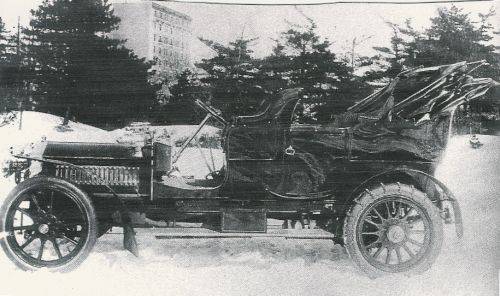
The
first Rolls to come to Canada, 1906, later sold in the U.S.A.
|
Meanwhile, Rolls was
busy
selling cars. Both Rolls and Royce had relatives in Ontario, and in
December 1906 Rolls came to Ontario to visit his relatives. He stayed
in Toronto with MacLean, the founder of McLeans magazine. He brought
with him this magnificent Roi des Belges touring car with body by
Barkers. If you look carefully, you can see snow chains on the back
wheels, and the car is standing in snow.
Rolls’ target market
was
the U.S.A., and in January 1907 he sold this car in the U.S.A.
|
|
The first car to sell
in
Canada was this 1907 car, sold to Fred Booth, son of the Ottawa
logging magnate. It too has a body by Barker. Booth did not keep the
car long, but soon ordered a newer car that he received in 1910.
|

The
first Rolls sold in Canada, 1907
|
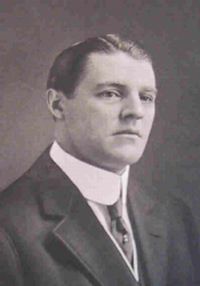
Capt.
C. M. Marpole
|
The first
Rolls-Royce car sold in Vancouver was bought in 1910 by this handsome
young man, Captain Clarence Mawson Marpole. His dates are 1878 to
1918. Marpole’s father was Richard Marpole who as General
Superintendent of the CPR had a major role in developing Shaughnessy
as a prestigious residential area. Marpole to the south of Vancouver
was named for Richard Marpole. Captain Clarence Mawson Marpole also
worked for the CPR from 1894 to 1899. Then he went in to business
with a partner, becoming President of MacDonald Marpole Co in 1901.
He was also president of Vancouver Tug and Barge and Managing
Director of B.C. Breweries. He was on the board of Vancouver General
Hospital and a member of most of the gentlemen’s clubs in
Vancouver. He did his bit in World War I, going to Europe with
General Stewart’s Railway Construction Corps. He was invalided home
in May 1918 and died aged only 38 in 1918. |
| Captain
Clarence
Mawson Marpole did not keep the car long. Here is the car, a 1910
Silver Ghost with a tourer body by Lawton. |
Marpole sold the car
to
Richard Vance Winch, born 1862, died 1952. Some of you must have
known him. Here he is.

Richard Vance Winch
He was born in
1862 in Cobourg, Ontario. He
ran away from home at age 16, herded cattle and worked on the CPR,
arriving in B.C. in 1893. He established Canadian Packers Canning on
the Fraser. In 1895 he shipped the first trainload of canned salmon
from B.C. and sold the first B.C. halibut in New York. In 1895 he
opened Queen Charlotte Fisheries. He owned seven canneries and a
sawmill. He erected the Winch building in 1909 (where you go for a
passport downtown).
|
1910 Rolls Royce Silver Ghost
with body by Lawton
|
I
came across Winch’s name recently in the book "Spilsbury's
Coast" thus. "R.V. Winch was in the insurance business, the
real estate business, the land business, he operated a string of
canneries up and down the coast - for half a century he was one of
the biggest movers and shakers in this part of the world. The Winch
building at Granville and Hastings, famous as the site of the
Vancouver Post Office Riot in the thirties, is still a Vancouver
landmark. Even in those days (the 1880's) old Winch's worth was in
the millions, although he had no schooling and was said to scrawl an
X for his signature. Then came the great depression - not the one you
and I think of, this was in the 1890's - and Winch went absolutely
broke. He lost all his money....(later) old Winch picked himself up
and started all over again ......".
Winch's
obituary notice in The Province newspaper of July 30th 1952 says:
"One of British Columbia's best-known businessmen, R.V. Winch,
died this morning. He was 89. His life story has been directly tied
up with the development of this province. Mr Winch ran away from home
at Coburg, Ontario, when only 16. He herded cattle across the
prairies and worked on a railroad gang at Lake of the Woods. Moving
out to B.C., he established the Canadian Pacific Canning Company on
the Fraser River in 1893. In 1895 he shipped the first trainload of
canned salmon ever exported from this province. They sold in
Liverpool, England, for about $5 per case. It was a shipment of
30,000 cases, on which Mr Winch said he cleared $1 per case. His
enterprise helped set up canneries at Nootka Sound and on the Naas,
Skeena and Fraser Rivers. He also built a cannery at Anacortes.
During his career he built and operated seven canneries and one
sawmill. At one time these were valued at $1,600,000. He built the
Winch building here in 1909 at a cost of $700,000. He is survived by
four sons and one daughter, Mrs Victor Spencer."
Richard
Vance Winch must have liked Rolls-Royce Silver Ghosts, because he was
the second owner of Marpole’s 1910 car and the first owner of a
1911 Ghost. Later in 1923 he bought a 1912 Ghost from another
Vancouver owner.
I
never met Captain Marpole or R.V. Winch, but I did meet Winch’s
daughter-in-law, a fine old lady living on Keith Road east of Taylor
Way. Mrs Winch told me she went on her honeymoon in 1914 in the 1910
car. She and her husband shipped the car to San Francisco and used it
to explore California before shipping it home. She told me that even
then, when it was only four years old, it was already out of date. It
had to be hand cranked and it had no electric lights.
The
1910 car was sold in 1920 to a Mr E. Hunter of New York, and by 1921
it was in Japan. Alas I can find no further history for it. However,
its radiator mascot was retained by Mrs Winch, and I was able to
purchase it in the 1980’s and have it still.
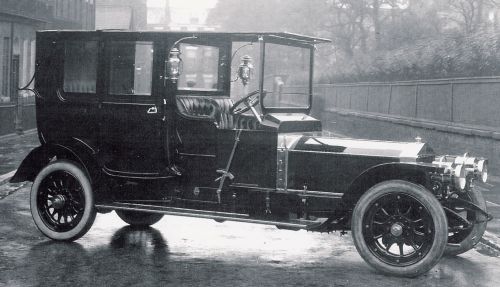
1911
Rolls Royce Landaulette, body by Lawton
|
Here
is Mr Winch’s 1911 car, also built by Lawton. This one has a
landaulette body. Landaulette is from the French, and a landaulette
body is one where the roof over the passengers can be opened. I think
the idea was your friends could admire you better as your chauffeur
drove you slowly around Shaughnessy.
All
I can discover about this car is that new cylinders and pistons were
purchased in 1919 and a set of clutch couplings in 1920. Winch's
son-in-law Colonel Victor Spencer had acquired the car by December
1933. It was probably abandoned at the Spencer property in the
Cariboo and sold as scrap metal together with much other machinery
from the property in the 1940's.
|
|
Victor
Spencer was the fifth son of the department store founder David
Spencer. Victor Spencer was born in 1882 and died in 1960. I’ve
heard his son Victor Junior attends the Legion here. Colonel Victor
became a Lt Colonel during World War I and after the war retained his
army title. He married Winch’s daughter.
|
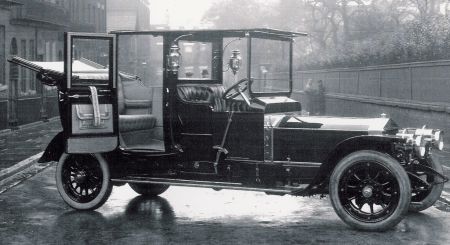
Winch's
1911 Rolls Royce Landaulette, with the top open
|
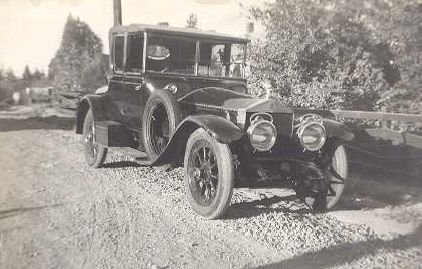
1911
Rolls Coupe, body by Barker
|
Time
for another car. This is another 1911 car. It carries a Barker
collapsible coupe body. It was bought in London, England, by the
Honourable Joseph Martin (1852 to 1923), a lawyer and a British M.P.
Martin took delivery in London in October 1911. By 1915, Martin’s
address was 445 Granville Street, Vancouver.
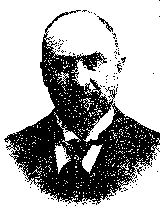 Joe Martin
Joe Martin
|
Here’s
Martin in his car. And here is Martin. Martin was born in Ontario and
came to Vancouver in 1897. He was elected to the B.C. legislature in
1898 and was briefly Premier in 1900. He lost his seat in B.C. and
moved to London, where he became an M.P. there. At the same time he
maintained a residence in Vancouver and ran unsuccessfully for Mayor
of Vancouver in 1915. He made a fortune from property in the
“Hastings Townsite” area. He died in Vancouver in 1923. Quite a
character. My lady friend, Winch’s daughter-in-law, remembered him
well.
After
Martin’s death, ownership of Martin’s Rolls-Royce passed to R.V.
Winch and then to his son-in-law Colonel Victor Spencer. Spencers
sold their department store to Eatons at the end of 1948, and about
the same time the car was sold. A Robert Wilton of Seattle bought it.
Then John Wallerich of Tacoma got it. As far as I know he is still
alive. The car was auctioned in Las Vegas in 1987. No-one seems to
know where it is today.
|
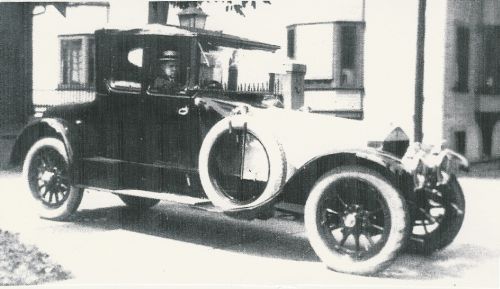
Joseph
Martin in his 1911 Rolls Coupe
|

Col.
Victor Spencer
|
Here’s
a neat story about this car. In 1982 a Mr Cameron Mackintosh was
introduced to me, and told me this story. “This Ghost with
collapsible coupe body was owned by Colonel Victor Spencer and was
stored in the Spencer garage on Hornby Street from 1929 till 1945. It
was a former Winch car (Winches related to Spencers); a Winch son
drove this coupe around the West End after school in the late 1920’s.
I often went with him. It was a four place cloverleaf, and had steel
spoke wheels, polished aluminum bonnet, and dark grey body. In 1942 I
inquired of Vic Spencer if the car was ever disposed of for an
opportunity to purchase. He said only after the Victory Parade at the
end of the war, then he would consider. However, after a couple of
years in the RCAF I returned to Southern California and later heard
the car went to Tacoma. I was given the original handbook and a copy
of the guarantee for the car by the service manager at Spencer garage
with whom I became friendly, as I haunted the car for years. However,
while I was in the service from 1942 to 1945 my family sold our home
in Point Grey and my library was boxed, put into storage, and
subsequently lost” |

1912
Silver Ghost, body by Barker
|
Here
now is the fourth and last car. This is a 1912 Silver Ghost with
coachwork by Barker. The picture is from the Vancouver Public Library
and shows the car by the hollow tree in Stanley Park. The woman in
the front seat is Ruth McLean, and she was still alive in 1999. In
the back seat are Jeannie MacLean and John William Stewart. I don’t
know who the third back seat passenger is, nor do I know the name of
the soldier who is driving. Dewey Parker identified the people, Ruth
McLean is her aunt. |
|
John
Stewart was born into a poor crofter’s family in Scotland in 1862.
He immigrated to Canada when he was 20 and joined the CPR as a member
of a survey crew. He quickly became an experienced railway
constructor, both in the USA and in BC. In 1908 he joined two
partners to form Foley, Welch and Stewart, the pre-eminent railway
builders in Canada in the pre WWI period. He was also a principal
partner in the logging company Bloedel, Stewart and Welch and first
president of the PGE Railway. In 1916 he organized a battalion of
railway construction workers and took them overseas. By the end of
WWI he was a Major General and director of military railways on the
British front. He died in 1938 in Vancouver.
In
1911 Mr Stewart decided to buy a Rolls-Royce. The chassis was
dispatched to Barkers on May 22nd, 1912. Stewart
presumably received his new car towards the end of 1912. By the time
the war ended the 1912 Rolls-Royce was no longer up-to-date.
None-the-less Stewart kept the car for at least seven years after the
war, with an order for spare parts being recorded in 1925. Soon after
that the car was sent to a used car lot on the Kingsway in Vancouver.
Alas, no-one wanted to buy it and it quickly deteriorated being open
to the weather.
|
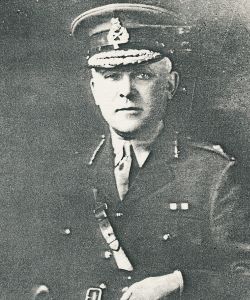
John
Stewart
|
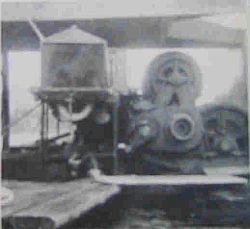
The Rolls-powered winch
|
Eventually
two young men, Rod Williams and Cliff Bristol, looking for a large
automobile engine, spotted the Rolls-Royce and recognized its
potential. They scrapped the body and axles, cut the frame behind the
gearbox, and took the rest to power a winch mounted on a floating
raft of logs. Their business involved floating along the coast line
of BC until they found a suitable tree, whereupon they would cut it
down and use their Rolls-Royce powered winch to pull the tree into
the water. When enough logs had been gathered, they would sell them
to a log buyer.
In
1960 a log buyer for MacMillan, Bloedel and Powell River Ltd.,
Geordie McLeod, took this picture a mile or two east of Alert Bay. He
helped prepare a story that was subsequently published in his
company’s house magazine, the “Digester” of May-June 1960. The
story and photo were repeated in the Province newspaper of 15
September 1960. Soon after that “someone in the States” bought
the Rolls-Royce engine. |
| Now
there’s a bit of a gap in the story. By 1979/1980 when I started
researching the car, Joe Loecy of Ohio had built up a chassis from
parts he had acquired. How many of the parts were from Stewart’s
car I don’t really know, but it got the vital chassis plate with
the VIN number. Joe told me he bought the remains from Gordon Smith
of Orillia, but Gordon told me it was not him. I visited Joe Loecy at
his workshop in Ohio in 1983, and he showed me the welds where he had
replaced the missing rear part of the frame. He found a suitable
touring car body on another derelict Silver Ghost, and produced a
stunning completed car at the 1991 Rolls-Royce Owners’ Club
National Meet in Monterey, California. The car subsequently changed
hands several times. Until mid 2005 Lawrence Smith in Wichita,
Kansas, was the owner, but he has recently sold it to Bruce Massman
in California. |

The
Silver Ghost was brought back to life in 1991
|
So
there you are. Four cars, two of which have survived, and a few big
names from Vancouver in the first half of the last century. I hope
you found some of this to be of interest. Maybe you can give me some
information on some of these people. If you can lead me to one of the
cars I will be very pleased. I will even pay you a finder’s fee if
I can acquire one.
BACK TO THE
HISTORY PAGE















